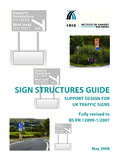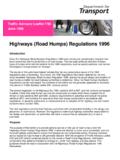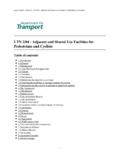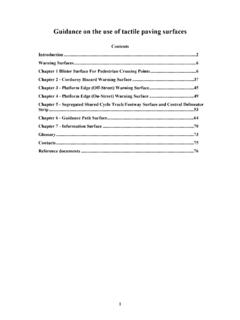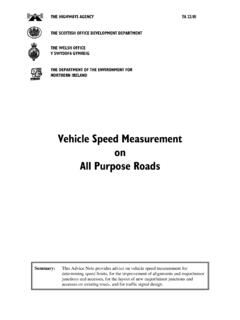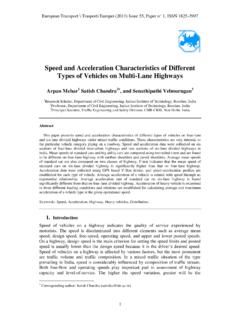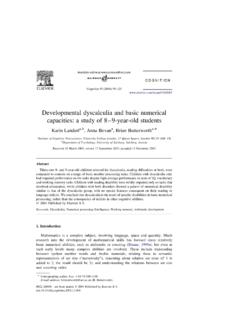Transcription of TRAFFIC ADVISORY LEAFLET - UK Roads
1 T RAFFIC A DVISORY L EAFLET 2/03. Signal-control at Junctions on High- speed Roads INTRODUCTION. When TRAFFIC signals change away from green, drivers have to decide whether they can safely stop, at an acceptable deceleration rate, or continue and clear the stop line before the start of red. On high- speed Roads the decision becomes more difficult with increasing vehicle speeds. High speed for signal- controlled installations is taken to mean a road where the 85th percentile approach speeds at a junction are 35 mph (56 km/h) or above. Measurement techniques are covered in TA 221. Close to, and far from, the junction, the decision is relatively easy.
2 The probability of an accident happening is highest for drivers making a decision between these points. The length over which decisions are deemed to be difficult is termed the dilemma zone and has been defined by the boundaries: The distance at which 10% of drivers stop when the signals change to amber The distance at which 90% of drivers stop when the signals change to amber. Signal-controlled junctions are not recommended where the 85th percentile approach speed exceeds 65 mph (104 km/h). Before installing stand-alone crossings on Roads where the 85th percentile is above 50 mph, serious consideration should be given to speed reduction measures.
3 This latter point is covered in Local Transport Note 1/952. March 2003. TRAFFIC ADVISORY Unit BACKGROUND. Work in the early 1960's by the then RRL, now TRL The solution was to measure the speed of approaching Ltd., considered the problems associated with TRAFFIC vehicles, using additional speed measuring detectors, signals on high- speed Roads . They looked at measures like further out from the stop line. These were used to longer amber periods and advance warning of the change calculate when the vehicle would reach the outer limit of to amber but decided on the use of additional detection. the dilemma zone.
4 Recent research, using sophisticated simulation techniques, has confirmed that their recommendations The philosophy was that before the driver reached the are still valid. dilemma zone it was safe for the signals to change, but once in the dilemma zone they would be given a fixed Their starting point was that the normal detectors (at the extension of the green time to take them well within the time a twin pneumatic tube, 130 feet, 39 metres, from the normal detection range. stop line) worked safely up to 30 mph. Over that speed , Once within the normal detection range the fixed drivers could be in difficulty, in a dilemma zone, before extension would run in parallel with the normal speed - reaching the detectors.
5 Timed extension. This also gave a measure of fine-tuning to compensate for any acceleration/deceleration after leaving the speed measuring detectors. speed Assessment DETECTION SYSTEMS. FOR HIGH speed SITES. The early work resulted in equipment specifications for use at high- speed sites. By the early 1970's, speed assessment (SA) and speed discrimination (SD) equipment was available utilising sub-surface inductive loop detectors. Two loops per lane are installed at each detection site to provide for speed measurement. These were to be supplementary to the standard system D detector system. Loop detector spacing for system D and SA and SD can be found in specifications MCE0108C3.
6 And TR2210A4. Both documents are essential reading. In addition to following the guidance on detector layout it is important that the standard timings, such as the maximum green and intergreen, are calculated correctly. Excessive green times encourage higher speeds, leading to an increase in accident potential and severity. SA is a direct consequence of the RRL work, giving a speed related period during which the signals can change, followed by a 5 second fixed extension which, at a constant speed , gets the driver to well within the system D . detection area. There is a simple formula in TR2210A4, which gives the speed -timed period.
7 SD is a simpler approach, giving a fixed extension if a vehicle is travelling above a minimum speed . There are two types double for 85th percentile speeds between 35. and 45 mph, giving a 3 second extension, and triple for 85th percentile speeds over 45 mph, giving a second extension at both additional detection points. Again, once the vehicle reaches the system D area the extensions run in parallel. The green can terminate: at the end of the minimum green, or after the last extension period, a gap change , or at the maximum green, a max. change . On a max. change, the controller will give two seconds extra all red.
8 Both systems can tend towards maximum green changes in both heavy and medium vehicular flows. This not only gives an arbitrary change from green but an increased intergreen which drivers begin to take as the norm. Double speed It must be stressed that if a junction, or stand-alone crossing, is within the high- speed category it must Discrimination incorporate either system D detection with SA or SD, as specified in MCE0108C3, or the MOVA system described next. Designers for sites in Scotland should seek advice from the Scottish Executive. Triple speed Discrimination * The distances shown are typical for a busy high- speed road.
9 The actual distance depends on the approach speed the measurement of which is set out in TRL Application Guide 459. MOVA. The only alternative is the Microprocessor Optimised Vehicle Actuation, MOVA , system. The MOVA signal control system was introduced in the 1980's. TRRL Research Report RR 1705. describes the system and RR 2796 the site trial work;. these documents may be a useful starting point to understand the principles of MOVA operation for managers. For general operation, reference should also be made to TRAFFIC ADVISORY LEAFLET 3/977. MOVA is now the general standard on all new and modified trunk road sites, see TD 358, unless (exceptionally) site circumstances dictate otherwise, for example in a UTC system.
10 MOVA maintains the green whilst the flow is maintained at, or above, saturation flow rate as determined by the standard MOVA. detector layout; once the end of saturation flow has been detected a delay optimisation process begins. If one or more lanes are oversaturated, MOVA uses a capacity-maximising algorithm instead of the delay-optimising process. For MOVA design and installation details, see TRL Application Guides 44 9 &. 4510, and for further explanations see MCH 1542C11. Correct design, data-set production, commissioning and validation are essential for the efficient and safe operation of MOVA, over the whole range of conditions.


